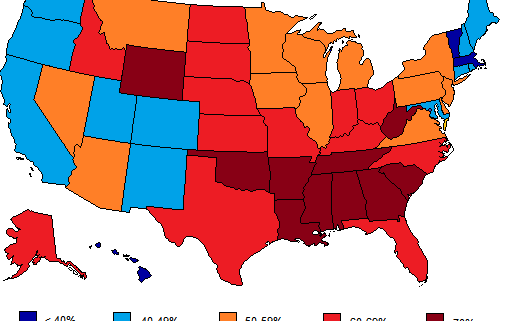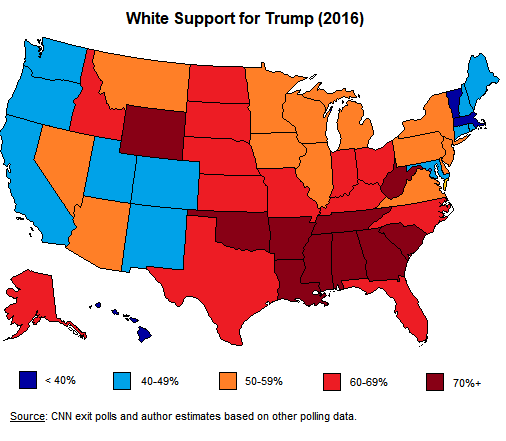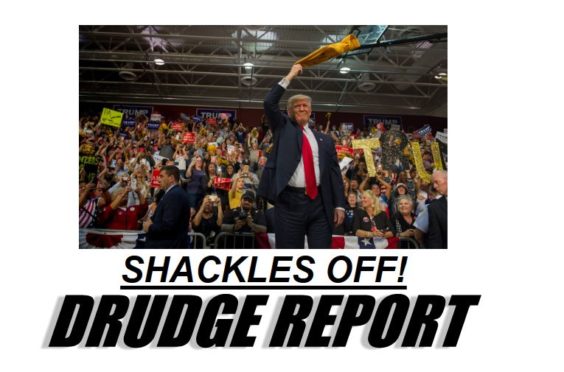Why It’s Important for Trump to Win
Trump’s 2016 victory was seen as nothing less than a cataclysm by the American establishment—the greatest shock to the system in memory and perhaps in the entire history of the Republic. After all, Trump was vehemently opposed by the entire establishment from far left to the neoconservative and Chamber of Commerce right. It was, one might say, a hostile takeover.
The left was on the cusp of going into end-game mode, so losing was incredibly frustrating, especially since Hillary Clinton was expected to win easily. But Trump won. Whatever you think of Trump’s actual performance, the fact is that throughout the campaign and since taking office the media and pretty much the entire left has been labeling him a Nazi and White supremacist (I wrote 5 articles for Vdare on this). And it’s continued, even into the recent presidential debate and the town hall hosted by Savannah Guthrie.
When Trump won, they were apoplectic — on the verge of complete victory with a “sure thing” Hillary victory, to having “White supremacists” in the White House. The tears that flowed after Trump won were replaced by anger and sheer hatred. The practical result was that Trump’s victory has had the effect of mobilizing the left.
And because this was framed from the beginning as a contest between the forces of good (our glorious multicultural future) versus evil (the “White supremacist” American past being promoted by the Orange Nazi in the White House), anything was justified. The media ought to throw out normal standards of journalism and do everything they can to destroy Trump’s image. Violence against Trump supporters and certainly against the dissident Right is entirely justified.
The result is a level of political polarization not seen in this country probably since the Civil War. But the polarization is what had to happen for any possible movement in the direction of the dissident right. The absolute worst thing would have been another Hillary-vs.-Jeb-type election where America keeps sleep-walking to Armageddon. The mobilization of the left has made clear the fault lines. This is about removing the traditional culture of America, and it is about removing Whites from the center of the American story. It is about replacement — first the monuments and the culture, then the people.
Solid majorities of Americans oppose removing the statues, and ratings for the now-politicized NFL, NBA, and MLB are way down, even though former sports fans are trapped in their homes with nothing much to do because of the pandemic. This means the traditional American majority is moving down the road toward being explicitly aware of what the game is. Reasonable White people watching this unfold cannot possibly believe that the glorious multicultural future will be anything but a disaster for White America. The hatred for White America that has been so obviously directed against activists on the dissident right is inevitably seeping through to “just plain White folks.” The hatred will only intensify when Whites have less power. And this means that the racialization of politics that we have emphasized so much here will accelerate. The ~60% of White America that votes Republican (not including Jews and other people grouped as Caucasians deriving from the Middle East and North Africa) will increase.
If the left wins they will go into end-game mode. They will establish a more-or-less permanent hegemony (via massive surge in legal and illegal immigration, amnesty to illegals and Dreamers, adding Puerto Rico and D.C. as states, and packing the Supreme Court). A Democrat victory would mark the end of the First and Second Amendments and likely lead to eventually locking up dissidents, as is already the case in Europe. There is now a rich body of academic literature by leftist academics (but I repeat myself) on reining in speech related to diversity. Their mantra is something like, “We won the intellectual war on issues related to race and gender. It’s all over, so anyone disagreeing with our pronouncements on race and gender can and should be shut down — your words do violence to muh feelings.” And liberals like Elena Kagan would love to use these ideas in majority opinions — indeed, she has already written on this.
With enough of a mandate, the Biden-Harris administration would also get rid of the Electoral College and two senators per state, resulting in the complete domination of the left-leaning urban centers—the issue has certainly been raised by many leftists since 2016. This is already the case in many states, such as California, where rural areas are effectively disenfranchised and all the statewide offices are held by Democrats, including around 75% of the State Legislature. The only Republican who could possibly win would be one who can fit into this new context, but even such a person could likely only win by taking advantage of some major Democrat screw up, like an economic depression or rampant corruption. In other words, once this happens, there’s no turning back. It’s over.
A Democrat victory would speed up the transformation of the educational system. Already, Critical Race Theory, which is basically anti-White hatred and guilt-tripping, has a strong foothold in the public schools and corporations. Trump outlawed teaching it to government workers, but that would change and there would likely be federal money for such programs at all levels of the educational system and for corporations.
Could the fact that Trump is attempting to appeal to Hispanics and Blacks undermine the GOP as the party of White people? It’s common for politicians to try to expand their base, and the fact is that these groups would benefit from many of the same policies that would benefit White America—opposing the defunding of police, curtailing immigration, and ensuring a robust economy (which Trump delivered on until the virus-induced lockdowns). Latinos in particular may be more open to Trump because of the national obsession with Blacks in the Summer of George.
No one is saying Trump is the savior, but the reality is that a great many White people are hopelessly caught up in the liberal/left mindset. This is especially true of educated Whites—the White working class has been solidly pro-Trump. These educated urban and suburban Whites are not going to vote Republican in the face of the constant stream of propaganda from the elite media and universities which has resulted in the left dominating the moral high ground, and in massive virtue-signaling and mindless conformity by great masses of liberal Whites whose hatred toward Trump has been fanned into a fever pitch by the elite media. No one on the dissident right saw Trump as the solution, but only as a stepping stone to a more explicitly White candidate. That is still possible, but only if Trump wins. In the meantime, trying to get non-Whites to vote for Trump makes a lot of sense.
In retrospect, it’s clear that the Trump victory in 2016 energized the left. There were riots in the immediate aftermath of the election and off-and-on throughout his term, crescendoing in the Summer of George—~130 straight days in Portland, with no serious effort to rein it in. The leftist media became nonstop Trump hate, and university professors routinely expressed their hatred in classrooms and in op-eds. Could one argue that a Biden victory would result in the civic peace and tranquility so eagerly desired by all those urban and suburban liberal Whites? I suppose it could, although in Portland the BLM-antifa have made leftist mayor Ted Wheeler a consistent target of their attacks, and they also turned on the mayor of Minneapolis, Jacob Frey; riots have continued to occur in cities dominated by very liberal-left mayors, such as New York and Atlanta.
But the question is, would a Biden victory be good for the dissident right, and the answer is no. The worst possible outcome would be to return to elections between Hillary types and Jeb types. Flip a coin, it really wouldn’t matter. We don’t really want peace and harmony. Polarization is good because the bipartisan center-left—center-right consensus is suicide but would just take a little longer than if Trump hadn’t come on the scene. But now that he attained the presidency, a victory by the energized, radicalized left would result in hegemonic, authoritarian control by the left and a complete eradication of expressions of White identity politics, opposition to immigration, public discussion of the genetics of race, likely the eventual shutting down of sites like The Occidental Observer, and even putting dissenters in prison. When I hung out with radicals in the 1960s, it was common to hear opinions like “worse will be better”—if the present system gets worse, it will ultimately result in a revolution of the left. But when a revolution of the left gains power, as would happen if Biden-Harris win, they will arrogate all power to themselves and ensure that it won’t be possible to give it up. Revenge and punishment will the the order of the day. Just recently Robert Reich, former Clinton administration Secretary of Labor, suggested Truth and Reconciliation commissions should be set up in the wake of a Biden victory on the model of South Africa after 1994—although what he really has in mind may more resemble Nuremberg and denazification that occurred after World War II.
A victory by Biden would be a green light for a return to power of neoconservatives like Bill Kristol, Max Boot, and Jennifer Rubin (who have more or less defected to the Democrats, but they would be happy to return to the GOP so that fanatically pro-Israel policies like war with Iran would be bipartisan). Another group eager to seize power in the wake of a Biden victory would be political operatives like those associated with the Lincoln Project, such as Rick Wilson and George Conway. Forget about a populist GOP. The GOP would once again be the party of Big Business (and hence liberal policies on legal and illegal immigration), wars for Israel, and tacit, if not overt, support for Critical Race Theory indoctrination. I realize that Trump has been gung-ho about doing things Israel wants, but he has stopped short of war and, in my opinion he has done all he can to extricate U.S. troops from the Middle East in the face of powerful opposition from the military (Trump accused them of gunning for post-career sinecures with defense contractors), the Israel Lobby, the media (where the left is dominated by liberal interventionists), and many politicians on both sides of the aisle. Just today Trump renewed pressure on the Pentagon to lower troop levels even further in order to fulfill his election promise, but the Pentagon is resisting the move.
On the other hand, another Trump victory would cement the populist wing of the party, where opposition to immigration is a major issue. Trump’s victories on immigration have been largely ignored by all sides, but as the LA Times notes,
He has targeted the Silicon-Valley based tech industry by squeezing high-skilled foreign labor, and has restricted immigration based on family reunification even as he’s separated thousands of migrant families at the border.
He has attempted to repeal federal protections for young immigrants who entered the country illegally as children and sidestepped the Supreme Court’s rejection of his plans. California has more residents covered by those protections, known as Deferred Action for Childhood Arrivals, or DACA, than any other state. He has also ended Temporary Protected Status for refugees from El Salvador and other Central American countries, a disproportionate number of whom live in the state.
And his administration has discouraged thousands of other students, refugees [refugee admissions dropped precipitously], asylum seekers, workers, and entrepreneurs — many headed to California — from coming to the United States at all, most recently by using the COVID-19 pandemic as a justification for largely shutting the nation’s borders.
Even more importantly, legal immigration has dropped by an astonishing 92 per cent in Fiscal Year 2020. Moreover, the fall in immigration workforce population predates Covid—apparently due to regulatory tightening. “Thanks, in part, to Trump’s (relatively) hard line on immigration, expressed basically via administrative measures, the Trump years saw a labor market where native-born Americans lost relatively fewer jobs than immigrants. This is not quite what Trump supporters had in mind in November 2016. But it’s something.”
Yes, and a Biden victory would end up being a radical reversal of these trends.
And finally, the Center for Immigration Studies:
Two new analyses of recently released Census Bureau data show that the total number of immigrants in the United States grew much more slowly 2017-2019 than in prior years, despite economic growth and low unemployment. This shows that the level of immigration is not a force of nature beyond our control, as many have suggested, but rather responds to policy changes. …
Trump administration policies that may have caused the slowdown include:
—A significant reduction in refugees allowed into the country;
—Requiring immigrant self-sufficiency through reform of the public charge rules;
—Mexico & Central American countries agreeing to offer safe haven to asylum seekers;
—Increased barriers and fencing at the border;
—More worksite enforcement against illegal workers and some employers;
—Efforts to end TPS and DACA, may have discouraged illegal immigration;
—Other modest administrative changes that may have had a cumulative effect.
A Trump victory would exacerbate the social unrest and polarization that has already reached levels not seen at least since the 1960s, but another Trump victory would unleash far greater violence than in the wake of his 2016 win. We have already seen the huge BLM-antifa crowds in urban areas and seen what they can do. It would be much worse as the left, anticipating another victory, would be plunged into despair and become further radicalized. Rioting in all the major cities is to be expected; indeed, the NYPD has already issued a memo saying “We should anticipate and prepare for protests growing in size, frequency, and intensity leading up to the election.” Riots are sure to exceed the violence that occurred after the 2016 election and the riots of this past summer, and continue for long thereafter. Attempts to shut them down, especially by the feds would likely look a lot like civil war—a civil war that I think the right would win at this point. But the longer this thing festers, the less likely that becomes.
As noted at the outset, the 2016 election was a huge defeat for our hostile elite, including the media. Another defeat would be an even greater catastrophe for them and a great victory for everyone else. Not only are the liberal-left media going all out to defeat Trump, now we have social media companies actively censoring information on covid from high administration officials and medical experts. Recently the social media companies and left-leaning newspapers and television (i.e., virtually all of them) have buried the New York Post series on the Hunter Biden-to-Joe Biden kickback scandal. The Trump administration is finally fighting back, suing Google under antitrust laws and reviewing Section 230 of the Communications Decency Act. “If Trump wins, Big Tech will know it’s screwed. The tech giants want to rig the election. Trump won’t forget that, and he will have the power and political capital to pay them back.” If Trump loses, this iron grip on information would be further empowered, even without going after the First Amendment. In effect, it would be a Ministry of Truth run by the private-sector and decidedly on the left.
Finally, the #1 reason to want a Trump victory would be simply to see massive crowds of Trump haters weeping on TV, a repeat of 2016, but much worse. I would just love to see the likes of Nicole Wallace, Joy Reid, Chris Hayes, Chris Cuomo, Don Lemon, and Lawrence O’Donnell, their faces grim, lashing out at Trump voters as racists, misogynists, haters, etc. Get out the popcorn!









 This phenomenon has inspired an important essay from
This phenomenon has inspired an important essay from 


